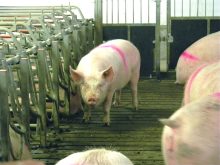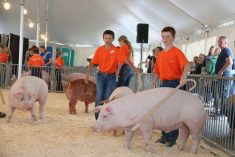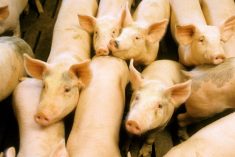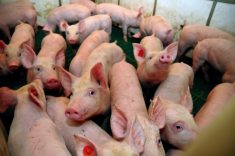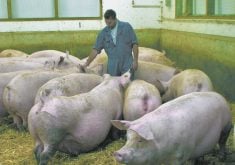Pigs that are only beginning to be affected by pathogenic infections typically yield the most insightful biological samples for laboratory analysis, meaning hog producers may need to euthanize otherwise healthy pigs if they want to get ahead of potential herd-threatening health issues.
That was the first message delivered by presenters from the University of Guelph’s Animal Health Lab and Woodstock-based Demeter Veterinary Services during the recent London Swine Conference.
Why it matters: Sampling animals early in the disease stage can help with diagnosing a problem before it causes a bigger health issue in the herd.
Read Also
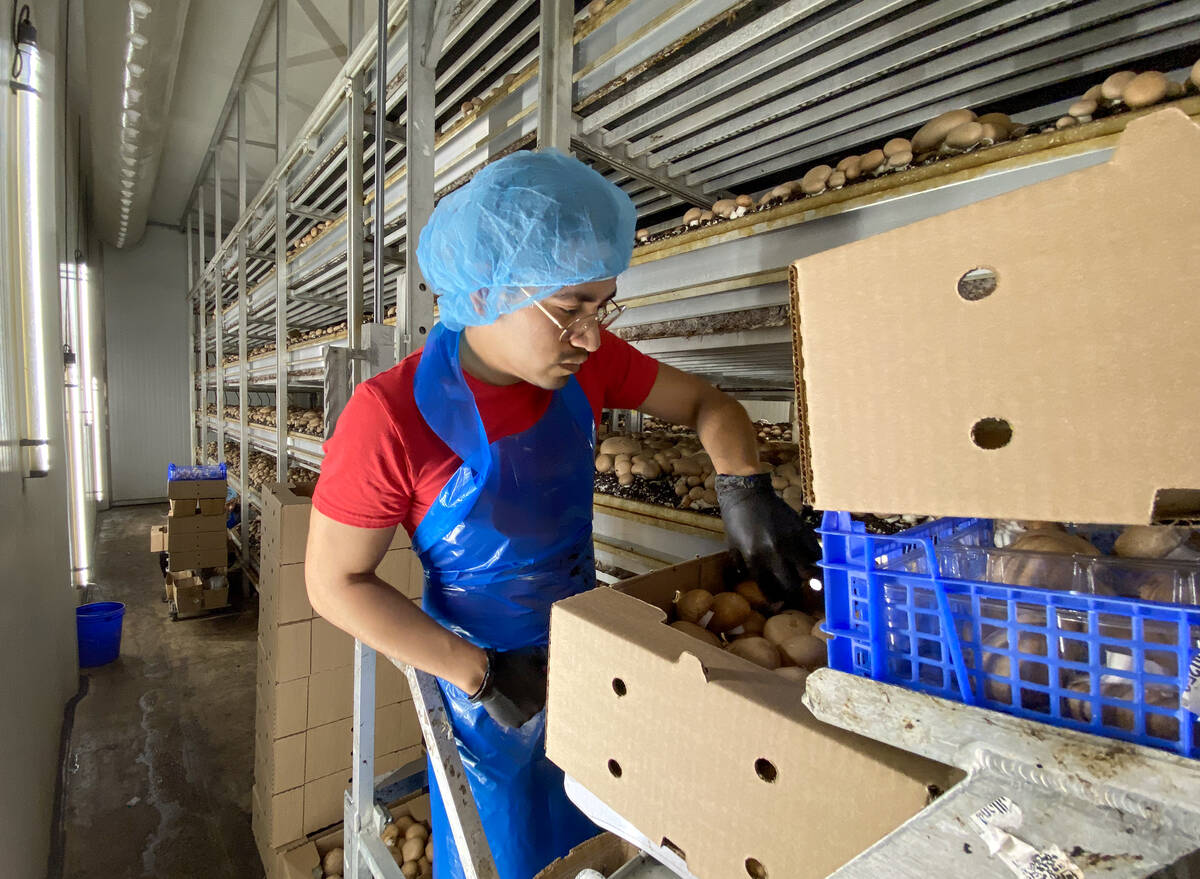
Ontario’s other economic engine: agriculture and food
Ontario Federation of Agriculture president, Drew Spoelstra, says Ontario’s agriculture and agri-food sector should be recognized for its stability and economic driving force.
The session included numerous takeaways for producers to optimize the possibility that lab results from pig post-mortems will determine what’s affecting the herd.
An informal introductory poll taken by University of Guelph mammalian pathologist Dr. Josepha DeLay revealed close to half the session attendees had conducted on-farm post-mortems. She said equipping the farm for post-mortems shouldn’t be complicated. Many of the tools she uses, she smiled, come from “the Canadian Tire post-mortem department,” including hedge trimmers, a handsaw, a bucket for hot water, paper towels for clean-up and paper plates for collecting and organizing samples.
“They’re clean and you can write on them,” she said of paper plates, “and labelling is very important.”
Ziploc bags aren’t only useful for holding samples but also for holding your phone. You can take photos to send to the vet or lab without worrying about contaminating your electronics.
Or, when tackling lameness or neurological issues, videos of still-walking pigs can be useful for diagnosis.
But she also makes sure she has a sharp knife – “you can do a lot with a good, sharp knife” – as well as a knife sharpener, scalpel, long tweezers and surgical scissors. And wear safety glasses.
“I was amazed, after I started wearing glasses, how much splatter there was on my glasses – of blood and tissue material. So before the glasses, it was going in my eyes.”
The same applies to wearing a surgical mask, DeLay said.
It’s “a luxurious environment” for post-mortems on whole pigs brought into the University of Guelph lab but she noted she also has lots of on-farm experience. “On the farm, sometimes the only place you have is the loading chute.”
When choosing a location, she offered, prioritize human health and comfort. A tractor loader or layers of small square bales can bring a pig up to a level where human back strain is less likely. Aim for good lighting; outside during the day is ideal.
The next step is choosing which pigs to sample. Demeter’s Dr. Ryan Tenbergen outlined six categories of health issues that typically lead to advice that samples should be taken: coughing/thumping, diarrhea, abortions/stillbirths, lameness, fading pigs, and sudden death.
Both the Demeter and univerisity specialists stressed the same point: sample the pigs that are only just beginning to show clinical symptoms.
“Chronic cases aren’t rewarding diagnostically,” said Demeter Veterinary Service technical production team member Gino Cruz, who assisted with the presentation.
With lameness, this means pigs that are still partially weight-bearing with possibly mild swelling that is still soft to the touch. “It’s pretty much good pigs that we need to euthanize,” DeLay lamented.
With gastrointestinal infections, look past the obviously dehydrated and low-energy pigs and search for a red, inflamed anus and wet rear legs on pigs that are otherwise still doing okay.
Preferably, samples should be taken from pigs that haven’t yet been treated with drugs. If you end up having to do a post-mortem on a treated animal, let the lab know so they have that context, said the presenters.
There are two streams of tissue typically required by laboratories: fresh tissue and tissue preserved in formalin. Often, the best practice is to submit one of each type of sample for testing. The other common testing method is on swabs taken of fluids or exudates. Blood samples can also be useful in fading pigs.
If you live half an hour away from the lab or a vet clinic (if you’re sending the samples through the vet clinic) and the samples will be put in formalin as soon as they arrive, you shouldn’t need to use formalin on-farm.
“But if it’s going to be 48 hours by courier, you need to find some formalin,” DeLay advised.
Samples from three pigs is a good balance between diagnostic efficacy and the availability of time and resources. It may not seem like very many from a scientific perspective but it’s still a large enough sample, she said, that it will allow for one “red herring” that doesn’t show the signs you’re looking for.
“If we’re lucky, all the pigs have the same lesions and they all return the same test results.”
DeLay performs post-mortems with the pig on its side; Tenbergen does small pigs on their back but switches to side access once they’re too big to lay on their back. Either way, the target is to open up the two abdominal cavities – the thoracic cavity with the heart and lungs; and the chest cavity.
For respiratory conditions, the tongue, trachea, lungs and heart – referred to as “the pluck” – can all be taken out at once. “We tend to concentrate on lungs when we’re opening pigs up but have a look at the trachea as well,” Tenbergen said.
With influenzas and PRRS, you’ll typically see so many respiratory tract lesions that it can be hard to figure out what’s what. In these cases, nasal swabs are also a good idea. But Tenbergen stressed that all types of swabs “are like Velcro. If you don’t have a steady hand, you can pick up a lot of stuff that you don’t want.”
Do the swabs first, before you touch anything. And follow up each swab with a tissue sample.
If it’s less clear, consider sampling the tonsils as they can harbour a lot of different diseases. This is true even for non-respiratory and non-digestive ailments.
“When I’ve struggled to find some of the bacterial causes of lameness in the joint, I’ve often been able to find it in the tonsils,” he said.
With gastro-intestinal infections, DeLay explained, “pig guts can be pretty voluminous and it can sometimes be pretty hard to figure out what’s what in the abdominal cavity.” A good first step is to familiarize yourself with the cecum. It’s a “landmark” organ that will help you find the ileum – the end of the large intestine. And the ileum is a great place to sample because it tends to collect a lot of disease organisms.
It’s important to immediately get gut samples after euthanasia. Try to get multiple samples from multiple areas of the digestive tract. “All the different causes of neonatal diarrhea look alike,” Tenbergen explained, “and sometimes it’s multiple causes.” So getting multiple samples throughout the tract is important.
With abortions or stillbirths, DeLay said, “I would prefer to get the entire litter that’s been aborted.” That’s because the sow’s uterus isn’t uniform. Piglets in one part of the uterus may be more susceptible to pathogens than piglets in a different part of the uterus.
Frozen piglets are okay if it’s going to take some time to arrange a delivery. This way, if you end up having additional abortions from other sows, you could send them all in together, thereby increasing the chances of a good diagnosis.
When sampling organs or bones located directly beneath the skin (either the brain, vertebrae or joints), use separate knives. With the skin, try holding the knife blade up so you don’t pull material down from the skin into the target organ or joint.
Brain swabs are important in sudden death investigations. Do them with the pig on its belly, taking the swab from where the brain and spinal cord meet. “With gravity, everything settles to the bottom of the brain,” DeLay explained, so this is the best location to take a sample.





